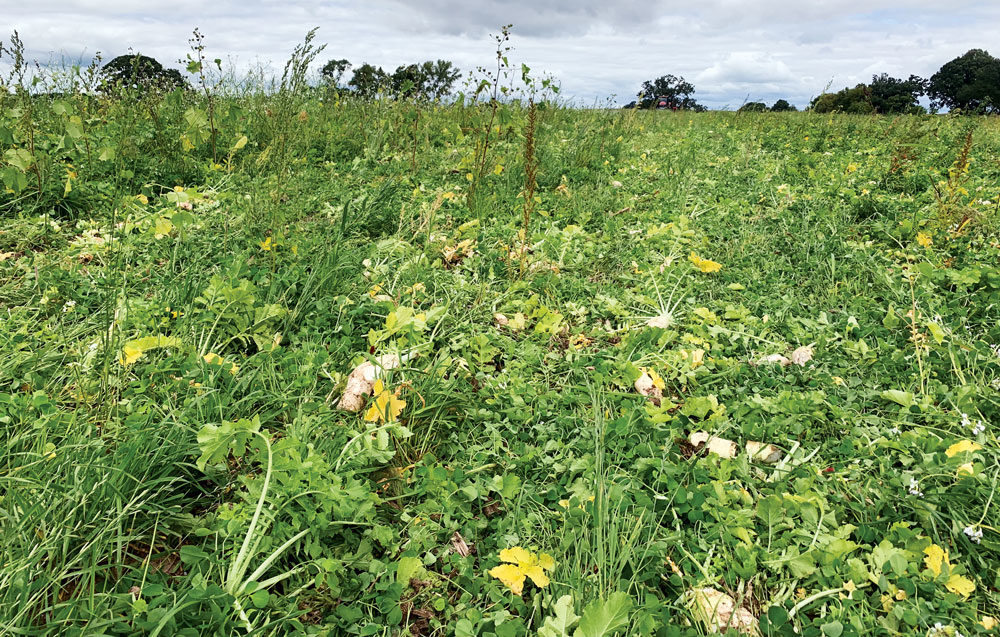Pictured Above: PREVENT-PLANT COVERS. The soggy spring of 2019 prevented Randolph, Wis., no-tiller Dale Macheel from planting a cash crop in a handful of fields. So that June, he seeded this mix of radishes and crimson clover instead. On Sept. 6 he seeded cereal rye into the green, growing cover crop, which he then terminated a week later. The following July, he harvested 45-bushel-per-acre rye for his own use and then seeded another cover crop.
Change can be difficult, especially if you’re bull-headed. Just ask Dale Macheel, who says he tends to be stubborn, just like most farmers. But it can also be fun, he says, a mindset he’s embraced while adopting conservation practices on his 2,500-acre cash grain operation in Randolph, Wis.
Just 5 years ago, Macheel, who has been farming since 1971 on and around the family farm where he grew up, was following the customary farming practices of the region — disc ripping in the fall and field cultivating in the spring. But his operation, which he farms with his son, Jonathan, is almost completely no-till now. He plants cover crops on all his acres and even plants green.
“We’re not 100% no-till. But we sold the disc ripper, and the only tillage we do is to incorporate cover crop seed in the fall,” he says.
Seeing is Believing
Macheel attributes his change in attitude in part to former NRCS soil scientist Ray Archuleta, who spoke at a Wisconsin Land & Water Conservation Assn. conference several years ago.
It wasn’t an instant conversion. “I thought Ray was nuttier than a fruitcake at the end of that meeting,” says Macheel.
And even though he’d read about soil health and that tillage destroys soil structure, “I just didn’t believe it,” he says, acknowledging his bull-headedness.
NO-TILL TAKEAWAYS
- Making the transition to no-till doesn’t necessarily mean getting all-new equipment right away — most planters can be adapted to start with.
- No-till can offer massive fuel savings right out of the gate.
- The timing of terminating cover crops should be based, in part, on the cash crop planting date.
But through his work with the association, he became more familiar with the real-life impacts of farming practices on the local watersheds and Archuleta’s message began to resonate. He soon decided to get involved with the Dodge County Farmers for Healthy Soil & Healthy Water (HSHW), a producer-led group that was getting established around that time.
Soon after he started working with HSHW, he watched a water infiltration test, the results of which truly surprised him. “For the second inch of water, in the field it took about 6 minutes for the water to absorb into the ground but at the fence line it took only about 1 minute,” he says.
He began his transition soon after by no-tilling some cover crops after soft red winter wheat and seeding cereal rye after soybeans on about 100 acres.
“It worked really well and we saw the benefits right away. Prior to that, we always had to kill off the weeds,” he says, adding that with the cover crops weeds became a much less significant issue.
Over the next couple of years, he expanded his no-till and cover crop experiment by a few hundred acres each year, and then rolled it out farm-wide.
He says getting involved with HSHW sped up his process of transitioning to no-till “by light years,” as the meetings offered a great resource for learning, asking questions and getting practical advice from other farmers in a similar environment.
Besides the ecological benefits he was seeing, Macheel says the economics of no-till were convincing.
“The first year after we stopped using the disc ripper, our fuel usage was cut in half,” he says. “Instead of four tankers a year, we’re down to two. Of course, if you’re going to lose 20 bushels an acre in yield it wouldn’t be worth it, but we didn’t see that.”
Green and Growing
Macheel’s farm consists of about 70% corn and 30% soybeans, and half of his soybean acres are seeded to winter wheat after soybean harvest. He seeds cereal rye after both corn and the remaining soybean acres, and seeds a tillage radish/crimson clover cover crop after wheat. Both corn and soybeans are no-tilled green in the spring.
Though his transition was relatively quick, Macheel didn’t invest in new equipment right away. When he first started no-tilling, he was using two Aulari applicators, each with a 12-row planter mounted behind it — one with a John Deere 1720, the other with a Case IH 1230 — a system that worked well with his dry fertilizer application. He added pneumatic down pressure and row cleaners, but says because he also started planting green right away, those adaptations weren’t really necessary for success with the new practice.
“Planting green is actually easier than planting through all that dry residue,” he says. “Having that living root in the soil improves planting conditions.”
But as he has adopted more new practices, his equipment lineup has seen some updates.
In 2020, the Macheels got a new 60-foot, 24-row Horsch Maestro SW 2430 corn planter to replace the Aulari applicators with attached planters. In addition to the double-disc openers and hydraulic down pressure that come standard, they added Martin row cleaners.
They replaced the OEM rubber closing wheels with cast iron finger wheels from SI Distributing to better close the furrow. A built-in weight-transfer system automatically transfers the weight to the row units during field operations, providing more even down pressure.
Soybeans are no-tilled with a 24-row Deere 1790 CCS planter on 20-inch rows, which Macheel says he prefers because the narrower rows may yield better than 30-inch rows. “They could be worse for white mold, though, and my son wasn’t happy with the uniformity of seed depth from row to row, so in 2021, we’re going to try planting some soybeans with the Horsch,” he says. They’re also replacing the openers on the 1790 with notched openers from Prescription Tillage Technology.
“Instead of four tankers [of fuel] a year, we’re down to two…” – Dale Macheel
Macheel takes his planting cues from the weather and soil conditions but has begun planting soybeans earlier as he’s learned they can tolerate cold, damp conditions better than corn can.
He’s also been experimenting with the timing of the cover crop termination. With soybeans, he tends to let the rye grow for 3-4 weeks after planting before terminating the rye. In 2019, he planted some soybeans this way in April, which was a few weeks earlier than he typically planted them in the past, and the soybeans averaged more 80 bushels per acre.
With corn, he has typically killed rye within 1-2 days after planting, but in one field in 2020 the rye escaped and he found it green and growing about 2-3 weeks after planting, so he did an emergency termination pass. To his surprise, that field yielded 240-250 bushels per acre, and as his overall farm average is around 200 bushels per acre, he plans to wait a little longer to terminate in 2021 than he normally would.
He knows he has to be flexible and base termination on when he gets planting done.
“You can wait longer to kill off your rye if you plant on April 30 than if you plant on May 30. If you plant at the end of May, the rye will already be tall and the corn will come shooting out of the ground faster, whereas at the end of April the rye is still growing and the corn takes longer to come out of the ground,” he says. “So I’ll probably kill off the rye right away if I plant at the end of May. But if I plant at the end of April, I don’t think that timing is as critical.”
Fertilizer Efficiency
Macheel says he uses dry fertilizer because he likes to place his phosphorus (P) and potash in the row rather than spread them on the soil surface. With the Horsch planter he variable-rate applies a blend of diammonium phosphate (DAP), ammonium sulfate (AMS), potash and zinc sulfate in a 2-by-2-inch configuration.
Nitrogen (N) rates are also variable, but one piece of advice Macheel got from the HSHW group was to make sure he was putting down enough N prior to planting corn to avoid taking a yield hit from the competition with the rye.
To that end, he broadcasts 40% of his N ahead of the planter as urea, then 10% goes on with the planter in the AMS and the rest is sidedressed as urea later in the season.
Having done several years of nitrogen-use efficiency (NUE) trials, he’s learned he can cut his N rate in half following the clover/radish/volunteer wheat cover crop part of his rotation, and by 30% after soybeans.
“We did a test after soybeans where we used a reduced N rate on one block — around 80 or 90 pounds per acre — and then used the full rate on the block right next to it and there was no yield difference,” he says. “We tried the same thing on corn-on-corn acres and there was a huge difference — enough to justify using the full rate.”
In 2021, he plans to mix some clover seed with the sidedress N applications as a test. Mixing the clover with the fertilizer is an attempt to get a cover crop seeded earlier in the season, which he sees as the biggest challenge in his system. He currently spins cover crop seed on after harvest using a RoGator with a New Leader spreader and then incorporates the seed using a Kuhn-Krause Excelerator.
This timing, however, means the covers don’t get a lot of growth before the winter freeze. Macheel did an aerial application one year and says it worked well but it was expensive. He has also used his 15-foot Case IH no-till drill to seed covers, but says he finds the Excelerator actually disturbs less soil than the drill.
“We used to do everything the same every year,” says Macheel. “But now every year is different. No-till has really made things more fun.”







